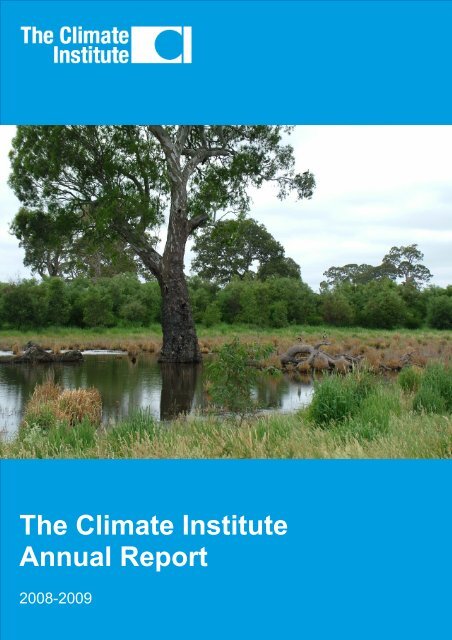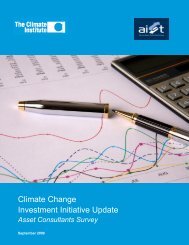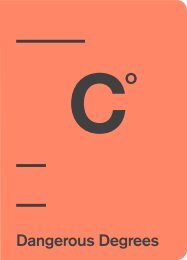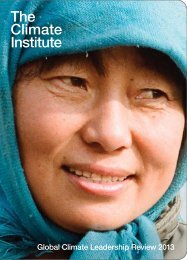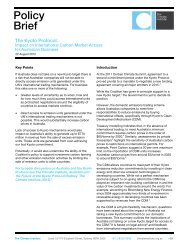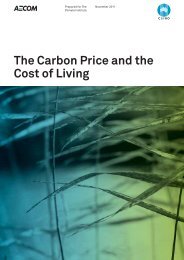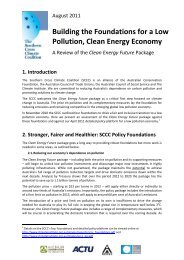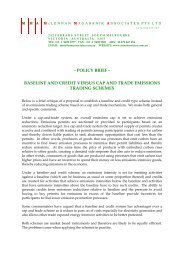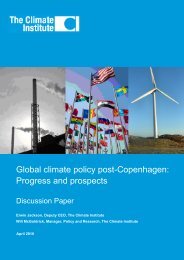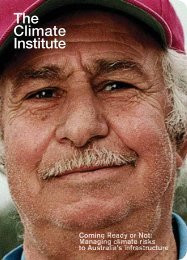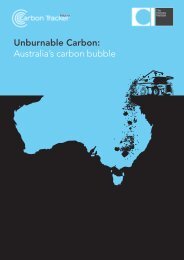The Climate Institute Annual Report
The Climate Institute Annual Report
The Climate Institute Annual Report
Create successful ePaper yourself
Turn your PDF publications into a flip-book with our unique Google optimized e-Paper software.
<strong>The</strong> <strong>Climate</strong> <strong>Institute</strong><strong>Annual</strong> <strong>Report</strong>2008-2009
CHAIR REPORT<strong>The</strong> <strong>Climate</strong> <strong>Institute</strong> Chair Mark WoottonIn 2005, when we set up <strong>The</strong> <strong>Climate</strong> <strong>Institute</strong>, it was based on the analysis that climate change demanded a ‘wholeof society’ response. We recognised the extreme urgency of the situation and the need for decisive commitment andaction from government and industry on a grand scale. What resulted was a non-partisan, independent researchorganisation which works with community, business and government to drive innovative and effective climatechange solutions. We research. We educate. We communicate.Unfortunately, the need for setting up <strong>The</strong> <strong>Climate</strong> <strong>Institute</strong> has not lessened in 2009. <strong>The</strong> urgency has onlyincreased.As a farmer, I have to deal constantly with the challenges of climate change and the continual need for adaptation. Iam particularly determined that the mitigation actions that are required by the clear and emphatic science be taken,quickly and decisively, by us all.<strong>The</strong> science, inconvenient as it is, tells us that as individuals, as communities, as businesses and as governments,we need to take unequivocal and dramatic action.This sense of urgency, coupled with dillusionment at the slow take up of initiatives needed to bring about thechange, makes it hard to remain positive. At times, this results in despair which can be overpowering.Yet, when I look at the progress in which <strong>The</strong> <strong>Climate</strong> <strong>Institute</strong> has been a significant player, I feel a real sense ofhope. In a bleak world it is a real beacon. It is a lighthouse based on the clear understanding that climate change isnot just an environmental issue. Amongst other things, it is an economic, health and a social justice issue. It has ahuman face. Solutions-based work such as that done at <strong>The</strong> <strong>Climate</strong> <strong>Institute</strong> provides us a clear compass by whichto set our journey.<strong>The</strong> success of <strong>The</strong> <strong>Climate</strong> <strong>Institute</strong> has been as a result of the valuable and strategic work of our staff, board andstrategic council. <strong>The</strong> leadership role we have played with a range of strategic partners and unusual bedfellows hashad clear and measurable positive outcomes.It is with pride that I look back at the space we have filled in the climate change debate. <strong>The</strong> <strong>Climate</strong> <strong>Institute</strong> hashelped to shape that debate. Yet we are not going to rest on our laurels; there is so much to do, so little time andunfortunately, so few resources to do it with.I commend this annual report to you and encourage you to engage in the work which is done by <strong>The</strong> <strong>Climate</strong><strong>Institute</strong>.Mark Wootton, ChairTHE CLIMATE INSTITUTE ANNUAL REPORT www.climateinstitute.org.au PAGE 2
CEO REPORT<strong>The</strong> <strong>Climate</strong> <strong>Institute</strong> CEO John ConnorOver this financial year, <strong>The</strong> <strong>Climate</strong> <strong>Institute</strong> continuedto focus on clear and credible communications, policydevelopment and research, as well as strategiceducation initiatives in an increasingly crowded andcontested climate change space.We launched, or continued, key partnerships withcommunity and business groups and reaffirmed ourfocus on the double dividend of an effective globalclimate agreement and prosperity for Australia in acarbon constrained world.In Australia, the past 12 months have seen the climatepolicy landscape ebb and flow with some dramaticchanges; however on another level, we are challengedby stagnation.It is an extremely significant achievement that we nowhave bi-partisan support for Australia committing to25% reductions off 2000 levels (24% off 1990), subjectto comparable global efforts. Getting the ambitioustargets and an effective global agreement is anothermatter but has to be the only prize worth fighting for.We see the conditions as realistic for the challenges ofachieving 450 ppm-e or lower, but only if Australia andother developed countries come forward with sufficientemission reduction targets and financing andtechnology transfer mechanisms to help developingcountries shift from business as usual. This is themajor priority for our policy advocacy. We’ll also needflexibility in any global agreement – reviews after thenext IPCC report in 2014 and a maximum 5 year periodfor commitments.While the bi-partisan support for the potential to go to25% is positive, the national commitments being put onthe table are short of those required for an effectiveglobal climate agreement that peaks emissions before2020 or heads towards 450ppm or lower. This willneed not only greater action on policy but also astronger diplomatic push from Australia and others.In our view, passage of an effective CPRS through theshoals of domestic climate politics will help boostambition in other countries and the internationalnegotiations. It will also provide greater clarity forinvestors already deferring investments in energy andother related infrastructure. But it needs to be effective.Senate amendments can’t constrain its ability to helpdeliver at least 25% reduction by 2020.Key research papers this financial year included:• Australia’s Carbon Pollution Reduction, ananalysis of Australia’s carbon pollution reductionpotential with an interactive Australian EmissionReduction Model where Australians can set theirown targets and policies and better understand thechallenges and opportunities of significantlyreducing our pollution by 2020.• <strong>The</strong> tens of thousands of jobs and tens of billionsof dollars of investment that can be mobilised fromeffective renewable energy and emission tradinglegislation, including a Google map of potentialrenewable energy job and investment locations.• Analysis of the May 2009 changes to GovernmentCPRS and potential pollution reduction targets,and why we gave them our qualified support.• Ongoing analysis of international policydevelopments, including pointing out themisunderstanding of the USA Waxman-Markey bill,also led to the development of an updated factsheet on global climate change action.THE CLIMATE INSTITUTE ANNUAL REPORT www.climateinstitute.org.au PAGE 3
• Low carbon finance, an examination of the issues,policies and mechanisms that will open the way forinvestment and financing of low carbon developmentin neighbouring developing countries – crucial to aglobal agreement.• Missing millions, a report of the millions of tonnes ofabatement and energy savings that the businesscommunity is sitting on because of apathy and policyuncertainty.• Clearing the air, analysing and rejecting a number ofbusiness myths being used to stall action.• National Strategy for Energy Efficiency, supportedby business, welfare, union and environment groups.• Proposals from Government and special pleadingfrom business groups that emission intensive tradeexposed companies should receive handouts arelikely to come at a substantial economic cost to thewider community, according to independenteconomic analysis.<strong>The</strong> details of all of the above reports can be found on <strong>The</strong><strong>Climate</strong> <strong>Institute</strong>’s website, www.climateinstitute.org.au.Through the Global <strong>Climate</strong> Network, <strong>The</strong> <strong>Climate</strong> <strong>Institute</strong>joined with leading research and educational institutesaround the world and embarked on a work program ofresearch with them.As well as conducting and communicating researchrelating to the national policy discussion, <strong>The</strong> <strong>Climate</strong><strong>Institute</strong> continued build strategic partnerships and toeducate and communicate in areas of investment, faithand agriculture. In July, for the first time peak social,union, research and environmental organisations formedan historic and powerful alliance to tackle climate change.This extraordinary alliance, the Southern Cross <strong>Climate</strong>Coalition, worked throughout the year to enable a fast andfair transformation of the Australian economy as well as toemphasise that all sections of society have an urgentresponsibility to act.<strong>The</strong> Southern Cross <strong>Climate</strong> Coalition is an alliance of <strong>The</strong><strong>Climate</strong> <strong>Institute</strong>, <strong>The</strong> Australian Conservation Foundation,<strong>The</strong> Australian Council of Social Service, and theAustralian Council of Trade Unions. <strong>The</strong> World Wide Fundfor Nature has become an increasingly active supporter ofthe work of the SCCC.<strong>The</strong> <strong>Climate</strong> <strong>Institute</strong>’s business program has made someexciting advances in high level discussions withsuperfunds about integrating climate risks andopportunities in the management of their funds. Ourfunds.CLEAN ENERGY JOBSTHE CLIMATE INSTITUTE ANNUAL REPORT www.climateinstitute.org.au PAGE 4
Partnering with the Australian <strong>Institute</strong> ofSuperannuation Trustees we conducted the world’sfirst survey of superannuation funds’ management ofclimate risks and opportunities.We discovered:• 83% consider climate risks as part of trusteeresponsibilities• 85% plan to increase their climate changecapability through staffing and trainingHowever, only 9% are trying to measure the exposureof their portfolio climate change risksThis survey was part of a broader Asset Owners<strong>Climate</strong> Investment Initiative. This also completed thefirst version of investment best practice methodologyand obtained agreements from significant fundsmanagers to trial this methodology. Super Ratingshave confirmed their involvement in year two of theasset owner’s survey.In partnership with the AIST we also hosted abreakfast in Melbourne at the Hyatt on Collins attendedby over 100 members of the investment community.<strong>The</strong> panel speakers, Professor Ross Garnaut, ErwinJackson (TCI) and Ian Robertson, Chairman of AISTand Trustee of the Local Government SuperannuationFund highlighted the challenges but also theopportunities of climate action.Building on past work, we also helped launch andsupport the Australian Religious Response to <strong>Climate</strong>Change (ARCC), providing information, liturgicalresources and tips for practical action for faithcommunities.Over the past 12 months we also provided support fora broad range of other community, conservation andyouth groups, including our support and hosting of theAustralian Youth <strong>Climate</strong> Coalition and the AustralianReligious Response to <strong>Climate</strong> Change as well assupport for conservation councils in SA, WA, Qld andNSW.<strong>The</strong> <strong>Climate</strong> <strong>Institute</strong> also continued to be a referencepoint for visiting delegations with engagement with UK,US, NZ, Canadian and German negotiators and/orMinisters. In May, TCI was also asked by the Danishembassy to facilitate roundtables with the Danish<strong>Climate</strong> Minister Connie Hildegaard and leadingindustry groups and NGOs.A timely review of the future of <strong>The</strong> <strong>Climate</strong> <strong>Institute</strong>was also conducted this year. <strong>The</strong> outcome was theagreement to move forward with a fundraising strategyand the appointment of a Director, Development toembrace new income streams and relationships.This will build on the extraordinary generosity of itsfounding supporter, <strong>The</strong> Poola Foundation (TomKantor Fund), which remained the overwhelmingfinancial support for <strong>The</strong> <strong>Climate</strong> <strong>Institute</strong>’s activitiesthis year.To broaden our outreach and to better inform our work<strong>The</strong> <strong>Climate</strong> <strong>Institute</strong> formed a Strategic Council at theend of 2008 with membership of Australia’s eminentscientists, economists, past political leaders, businessleaders and climate-interested philanthropists andcommunity leaders. <strong>The</strong> Council members met twice in2008/09 and were given detailed briefings on nationaland international developments.For a small team and relatively small budget I amextremely proud of the efforts and impact of <strong>The</strong><strong>Climate</strong> <strong>Institute</strong> and its staff over this year. <strong>The</strong>challenges and opponents for the coming 12 monthsare substantial but I remain optimistic that the urgencyand opportunities of climate action will prevail!John Connor, CEOTHE CLIMATE INSTITUTE ANNUAL REPORT www.climateinstitute.org.au PAGE 5
THE IDEA<strong>The</strong> <strong>Climate</strong> <strong>Institute</strong> was established with the goal of raising public andpolitical awareness about the dangers to Australia of global warming and tomotivate people and governments to take positive action.<strong>The</strong> <strong>Climate</strong> <strong>Institute</strong> is a Sydney and Melbourne - based non-partisan, independent research organisation.Among its Board of Directors are scientists and policy experts who are world leaders in their fields.Founded in 2005 by <strong>The</strong> Poola Foundation (Tom Kantor Fund), <strong>The</strong> <strong>Climate</strong> <strong>Institute</strong> has, in its brief history, recorded animpressive number of achievements on climate change issues.<strong>The</strong> <strong>Climate</strong> <strong>Institute</strong> works with partners, including government agencies, academic institutions, business, industrygroups and non-government organisations.<strong>The</strong> <strong>Climate</strong> <strong>Institute</strong>’s expertise and leading research, has made it an influential media commentator and public educator.TCI has been particularly active and influential:• Highlighting clean energy and low carbon job and investment opportunities• Developing solutions for farmers and regional Australia• Revealing the devastating and growing link with bushfires• Identifying ambitious but achievable policy solutions• Transforming investment considerations of large fund managers• Supporting faith, youth and other community groups to engage and educateTHE CLIMATE INSTITUTE ANNUAL REPORT www.climateinstitute.org.au PAGE 6
“I am impressed with the integrity andprofessionalism of <strong>The</strong> <strong>Climate</strong> <strong>Institute</strong> and theirdedication to ensuring that we address the climatechange crisis as a matter of the highest priority.<strong>The</strong>y deserve to be supported so that they cancontinue this vital role at such an important timein our history.”- Dame Elisabeth Murdoch AC DBE
THE THREATWithout decisive action, the economic and environmental threat that climate change represents will increasingly affectus all. Decisive action, however, can not only significantly boost clean energy and low carbon jobs and industries, itcan create societies better in touch with natural and regional communities. <strong>The</strong> <strong>Climate</strong> <strong>Institute</strong> is an important andinfluential organisation in the climate change space and is widely regarded as an Australian “thought leader”.<strong>The</strong> <strong>Climate</strong> <strong>Institute</strong>’s key strength is its sole focus on the issue of climate change, integrating both national andinternational dimensions.<strong>The</strong> <strong>Climate</strong> <strong>Institute</strong>’s critical research and analysis of climate impacts, community attitudes and economic risks andopportunities has clearly contributed to significant developments in policy and practice. <strong>The</strong>se findings are strategicallytimed and targeted to educate and influence community, business and political leaders who have the power to effectpositive change.THE CLIMATE INSTITUTE ANNUAL REPORT www.climateinstitute.org.au PAGE 8
“<strong>The</strong> <strong>Climate</strong> <strong>Institute</strong> has played a unique andvital role in getting the Australian Governmentto address climate change. More is clearlyneeded, and there is no group betterpositioned to deliver it than <strong>The</strong> <strong>Climate</strong><strong>Institute</strong>.”- Tim Flannery
THE VISION<strong>The</strong> <strong>Climate</strong> <strong>Institute</strong>'s focus is on a double dividend of an effective global climate agreement and a fast andfair transition to prosperity for Australia in an already emerging global clean energy and low carboneconomy.Our vision for Australia is for our country to lead the world in clean technology use, innovation andinvestment, with clean and low carbon solutions a part of everyday life throughout the community,government and business.<strong>The</strong> <strong>Climate</strong> <strong>Institute</strong> recognises this is a global problem requiring a global solution and as such has a focuson Australia's climate diplomacy.At least three things need to be better understood and/or implemented by business, community andpoliticians:1. <strong>Climate</strong> action is already creating jobs, investment and profit and this will continue to be the case in aworld hungry for clean energy and low carbon technologies. And delay is already costing!2. Risk management is not just about preparing for climate impacts already upon us (which will get worse),nor is it is just about hedging investments to avoid sub-clime risks -- it is also about not missing the lowcarbon economic train already leaving the station around the world.3. A cost and risk effective approach to improving carbon productivity is necessary, and this requirespolicies and practices driving technological innovation.THE CLIMATE INSTITUTE ANNUAL REPORT www.climateinstitute.org.au PAGE 10
WORKING TOGETHERProfessor Ross Garnaut and <strong>The</strong> <strong>Climate</strong> <strong>Institute</strong>’s Erwin Jackson<strong>The</strong> <strong>Climate</strong> <strong>Institute</strong> has a principled but pragmatic approach which eschews incrementalism butconcentrates on ambitious but achievable outcomes. This also gives us freedom to work with a range ofstakeholders to bring about change.<strong>The</strong> <strong>Climate</strong> <strong>Institute</strong> has led the formation of crucial partnerships on a strategic project or ongoing basis,including:<strong>The</strong> <strong>Climate</strong> <strong>Institute</strong> led the formation of the Southern Cross <strong>Climate</strong> Coalition, a coalition of peak orleading Australian labour, welfare, environment and research groups including the Australian Council ofSocial Service, Australian Council of Trade Unions, Australian Conservation Foundation, supported byWWF;<strong>The</strong> <strong>Climate</strong> <strong>Institute</strong>'s partnership with the Australian <strong>Institute</strong> of Superannuation Trustees (AIST) hasbacked an innovative and increasingly influential approach to funds management;<strong>The</strong> <strong>Climate</strong> <strong>Institute</strong> is a foundation member of the Global <strong>Climate</strong> NetworkLINK of leading nationalresearch organisations including the Center for American Progress, the UK <strong>Institute</strong> for Public PolicyResearch and the Chinese Research Center for Sustainable Development;<strong>The</strong> <strong>Climate</strong> <strong>Institute</strong> provides project and other support for the Australian Religious Response to <strong>Climate</strong>Change (ARRCC) and the Australian Youth <strong>Climate</strong> Coalition (AYCC) and a range of conservation councilsand community groups.“<strong>The</strong> <strong>Climate</strong> <strong>Institute</strong> has introduced analysis andinformation to the climate change debate. <strong>The</strong> qualityof public discussion would be incomparably poorerwithout it. <strong>The</strong> work of <strong>The</strong> <strong>Climate</strong> <strong>Institute</strong> hasopened the way for better public policy outcomes.- Professor Ross GarnautTHE CLIMATE INSTITUTE ANNUAL REPORT www.climateinstitute.org.au PAGE 11
RESEARCH & ANALYSIS<strong>The</strong> <strong>Climate</strong> <strong>Institute</strong> has commissioned ground breaking clean energy economic analysis on theimportance of combining policies in a cost and risk effective way and which seeks to develop a portfolio ofoptions at commercial scale by 2020. This approach recognizes that one or more of the promisingtechnologies in which Australia has potential competitive advantages, e.g. solar, geothermal, carbon captureand storage, may not prove to be viable.Other economic analysis prepared by or for <strong>The</strong> <strong>Climate</strong> <strong>Institute</strong> has allowed for the direct challenge orrefutation of economic misrepresentations about jobs and economic growth impacts. Indeed <strong>The</strong> <strong>Climate</strong><strong>Institute</strong> makes the economic case for climate action -- demonstrating how addressing climate change isgood for the economy, jobs, growth and business/industry competitiveness.<strong>The</strong> <strong>Climate</strong> <strong>Institute</strong>'s economic analysis has been communicated effectively with short briefing papers thatmake the issues accessible. <strong>The</strong> <strong>Climate</strong> <strong>Institute</strong> has also used a range of innovations such as Googlemaps of new clean energy job locations and superannuation calculators showing the impact on citizen'ssuperannuation (pension) funds of delayed action.With its partner the Australian <strong>Institute</strong> of Superannuation Trustees (AIST), <strong>The</strong> <strong>Climate</strong> <strong>Institute</strong> conductedthe world's first survey of superannuation (pension) and other large funds managers regarding theirapproach to climate risks and opportunities. <strong>The</strong> results of this survey include the fact that while 80% oftrustees believe acting on climate risks is part of their responsibility only 9% were taking action. <strong>The</strong> <strong>Climate</strong><strong>Institute</strong> is working with a number of these funds to assist the implementation of best practice methodology,and will be repeating the survey annually. <strong>The</strong> <strong>Climate</strong> <strong>Institute</strong> is partnering with other global stakeholdersseeking to take this innovation worldwide.THE CLIMATE INSTITUTE ANNUAL REPORT www.climateinstitute.org.au PAGE 12
SUSTAINABILITY<strong>The</strong> <strong>Climate</strong> <strong>Institute</strong>’s 5-Star Green Star rated offices<strong>The</strong> <strong>Climate</strong> <strong>Institute</strong> works to minimise its eco-footprint and promote sustainability within its office operations byoffsetting emissions and locating its headquarters in a resource-efficient 5 Star Green Star-rated office space.A five-hectare site has been set aside at <strong>The</strong> <strong>Climate</strong> <strong>Institute</strong> Chair Mark Wootton’s Jigsaw Farms, in Hamilton,Victoria, to offset the activities of <strong>The</strong> <strong>Climate</strong> <strong>Institute</strong>. <strong>The</strong> site is composed of permanent mixed indigenous planting,and is Kyoto-compliant. Based on National Carbon Accounting Toolbox modelling, the site sequesters 19,767 tons ofCO 2e during its lifetime.Additionally, all flights taken by <strong>The</strong> <strong>Climate</strong> <strong>Institute</strong>’s staff, consultants and international guests are calculated andoffset on a calendar year basis through <strong>Climate</strong> Friendly (www.climatefriendly.com). All carbon credits purchasedthrough <strong>Climate</strong> Friendly are sourced from accredited renewable energy projects that contribute to sustainabledevelopment.<strong>The</strong> <strong>Climate</strong> <strong>Institute</strong>’s Sydney headquarters are located in office space retrofitted by the Green Building Council ofAustralia which has a 5 Star Green Star Office Interiors V1.1 rating, signifying Australian excellence in environmentallysustainable design.<strong>The</strong> office space has been built using a minimal amount of materials, with exposed ceilings that reduce the use ofplasterboard/ceiling tiles and recyclable carpet held down by adhesive stickers instead of glue.A grey water system collects the water used in the sinks and dishwasher, filters out all solids, and then reuses thewater to flush toilets and urinals.A highly energy efficient displacement air conditioning system heats and cools the space, and indoor plant walls act asbiofilters to turn CO 2 into oxygen. Lighting within the office is connected to an automated system, which providesenergy efficiency, and meeting and boardroom lights are run on a sensor system. Automated blinds are installed onevery window to control light penetration, air and heat.<strong>The</strong> office is designed to both achieve environmental excellence and provide a healthy workspace for its employees.THE CLIMATE INSTITUTE ANNUAL REPORT www.climateinstitute.org.au PAGE 13
A five hectare site of permanent mixed indigenousplanting at <strong>The</strong> <strong>Climate</strong> <strong>Institute</strong> Chair MarkWootton’s Jigsaw Farm in Hamilton, Victoria isdedicated to offsetting the emissions of <strong>The</strong> <strong>Climate</strong><strong>Institute</strong>.
SUPPORTING THE COMMUNITY<strong>The</strong> <strong>Climate</strong> <strong>Institute</strong> has provided project and othersupport for the work of the following organisations:Australian Religious Response to <strong>Climate</strong> ChangeNature Conservation Council of NSWConservation Council of SA IncConservation Council of WA IncQueensland Conservation CouncilCentre for Policy DevelopmentAustralian Youth <strong>Climate</strong> CoalitionTHANK YOU<strong>The</strong> following organisations have provided pro bonosupport in 2008/09, which is greatly appreciated:Arnold Bloch LeiblerBaker & McKenzieGaden’s RidgewayMcLennan Magasnik AssociatesCommunications & Public Relations (CPR)AuspollEcoperspectivesAustralian <strong>Institute</strong> of Superannuation TrusteesTHE CLIMATE INSTITUTE ANNUAL REPORT www.climateinstitute.org.au PAGE 15
THE CLIMATE INSTITUTE BOARDMark Wootton (chair) with his wife Eve Kantor own,manage and live on a 12,000 acre grazing property atHamilton, Victoria. Mark is also a director of the Poola Foundation. Poola’s current main responsibility is to distributethe funds of the late Tom Kantor, Eve’s brother. $10-millionfrom this fund has been used to establish <strong>The</strong> <strong>Climate</strong><strong>Institute</strong>. <strong>The</strong> impetus for this was simple: a belief that theextreme urgency of the situation requires decisivecommitment and action from government and industry on agrand scale. Mark is also Chair of the Glenelg HopkinsCatchment Management Authority and is a board member ofthe Victorian Ministerial Council for <strong>Climate</strong> ChangeAdaptation.John Connor, CEO of the <strong>Climate</strong> <strong>Institute</strong>, initially trainedas a lawyer and worked as a research assistant for a Judgein the Land and Environment Court of NSW. After a stint asan environmental consultant to business he became aresearcher for Dr Peter Macdonald the Independent memberfor Manly, during and after his role in holding the balance ofpower for the minority coalition government of the time. Fromthere he ran the Nature Conservation Council of NSW andthen moved to the Australian Conservation Foundationhelping forge links with farmers and business developingsolutions on salinity and climate change. John most recentlyworked for World Vision where he co-convened the MakePoverty History campaign. John joined the <strong>Institute</strong> in March2007.Susan Jeanes is the Chief Executive of the AustralianGeothermal Energy Association (AGEA) the national bodyrepresenting the Australian geothermal energyindustry. Susan is also Managing Director of new energydirections (ned). ned works with progressive energycompanies to promote their contribution to climate changeand sustainability solutions to government and to the generalpublic.Susan has previously worked in the political arena,serving in the Federal Parliament as the Member forKingston and working as an Advisor to the formerEnvironment and Heritage Minister Robert Hill on climatechange and energy policy. She has also worked for anumber of shadow ministers in various portfolio areas priorto the election of the Howard Government in 1996. Susanalso held the position of Chief Executive of the RenewableEnergy Generators of Australia (REGA) until October 2007.Adam Kilgour is Managing Director of the SpecialisedCommunications Division for the ASX listed Photon GroupLtd and a member of its Executive Committee. He isresponsible for 16 companies in Australia, New Zealand,United Kindom, China and the USA. Adam is also Chairmanof Stirling Henry Global Migration.Clare Martin brings a wealth of experience to the <strong>Climate</strong><strong>Institute</strong> through her work in journalism, and public life. MsMartin was elected to the Northern Territory LegislativeAssembly in 1995 and appointed Opposition Leader in 1999.She was elected the Northern Territory’s first female ChiefMinister in 2001 and served in that capacity until 2007,retiring from Parliament in 2008. She is currently CEO of theAustralian Council of Social Service.Professor Tony McMichael is an environmentalepidemiologist, at the Australian National University (ANU),Canberra, with a long record of research and publication.During 2001-2007 he was Director of the National Centre forEpidemiology and Population Health at ANU. He has, overseveral decades, advised the World Health Organization, theUN Environment Program and the World Bank on matters ofenvironmental risks to health. During 1993-2007 he played acentral role in the assessment of health risks due to climatechange for the UN's Intergovernmental Panel on <strong>Climate</strong>Change (IPCC), as an Australian Government-nominatedscientist. He is currently assisting the World HealthOrganization develop that body's newly-mandatedinternational program of research and risk management inrelation to climate change and human health. He issupported by a prestigious five-year Australia Fellowshipfrom the National Health and Medical Research Council(NHMRC).Dr. Graeme Pearman was elected to Fellowship of theAustralian Academy of Science in 1988 and has been amember and chair of many Australian and internationalmeteorological/global change committees. Graeme was theformer head of CSIRO Division of Atmospheric Research.He was also a recipient of a United Nation’s EnvironmentProgram Global 500 Award in 1989 for his activeinvolvement in a national awareness program on climatechange and in 1999 he was awarded the Australian Medal ofthe Order of Australia for his services to atmospheric scienceand promotion of the science of climate change to the public.Dr Hugh Saddler is currently a Principal Consultant withPitt&Sherry and the Managing Director of SustainabilityAdvice Team Pty Ltd. He is also an Adjunct Professor at theAustralian National University. He has a degree in sciencefrom Adelaide University and a PhD from CambridgeUniversity. He is the author of a book on Australian energypolicy, Energy in Australia, and over 70 scientific papers,monographs and articles on energy technology andenvironmental policy, and is recognised as one of Australia'sleading experts in this field.THE CLIMATE INSTITUTE ANNUAL REPORT www.climateinstitute.org.au PAGE 16
CLIMATE INSTITUTE (AUSTRALIA) LIMITEDA COMPANY LIMITED BY GUARANTEEACN 116 713 592DIRECTORS’ REPORTYour directors present their report on the company for the financial year ended 30 June 2009.<strong>The</strong> names of the directors in office at anytime during or since the end of the year are:Cathy Zoi (Resigned 19/6/09)Adam KilgourTony McMichaelHugh SaddlerMark WoottonJohn ConnorGraeme PearmanSusan JeanesClare Martin (Appointed 21/7/08)Directors have been in office since the start of the financial year to the date of this report unlessotherwise stated.<strong>The</strong> net profit of the company for the financial year after providing for income tax amounted to$141,110.A review of the operations of the company during the financial year and the results of thoseoperations are as follows:<strong>The</strong> review found the operations to be in line with the projected budget for the year ended 30 June2009.No significant changes in the company’s state of affairs occurred during the financial year.<strong>The</strong> principal activities of the company during the financial year were:Research into climate issuesNo matters or circumstances have risen since the end of the financial year which significantlyaffected or may significantly affect the operations of the company, the results of those operations, orthe state of affairs of the company in future financial years.Likely developments in the operations of the company and the expected results of those operationsin future financial years have not been included in this report as the inclusion of such information islikely to result in unreasonable prejudice to the company.<strong>The</strong> company’s operations are not regulated by any significant environmental regulation under a lawof the Commonwealth or of the State.No dividends have been paid or declared since the start of the financial year.THE CLIMATE INSTITUTE ANNUAL REPORT www.climateinstitute.org.au PAGE 17
CLIMATE INSTITUTE (AUSTRALIA) LIMITEDA COMPANY LIMITED BY GUARANTEEACN 116 713 592DIRECTORS’ REPORTNo options over issued shares or interests in the company were granted during or since the end ofthe financial year and there were no options outstanding at the date of this report.No indemnities have been given or insurance premiums paid, during or since the end of the financialyear, for any person who is or has been an officer or auditor of the company.No person has applied for leave of court to bring proceedings on behalf of the company or intervenein any proceedings to which the company is a party for the purpose of taking responsibility onbehalf of the company for all or part of those proceedings.<strong>The</strong> company was not a party to any such proceedings during the year.Auditor’s Independence DeclarationA copy of the auditor's independence declaration as required under Section 307C of the CorporationsAct 2001 is attached to this financial report.Signed in accordance with a resolution of the board of directors:THE CLIMATE INSTITUTE ANNUAL REPORT www.climateinstitute.org.au PAGE 18
CLIMATE INSTITUTE (AUSTRALIA) LIMITEDA COMPANY LIMITED BY GUARANTEEACN 116 713 592AUDITOR’S INDEPENDENCE DECLARATION UNDER SECTION 307C OFTHE CORPORATIONS ACT 2001I declare that, to the best of my knowledge and belief, during the year ended 30 June 2009 there havebeen:(i)(ii)No contraventions of the auditor independence requirements as set out in the CorporationsAct 2001 in relation to the audit and;No contraventions of any applicable code of professional conduct in relation to the audit.THE CLIMATE INSTITUTE ANNUAL REPORT www.climateinstitute.org.au PAGE 19
CLIMATE INSTITUTE (AUSTRALIA) LIMITEDA COMPANY LIMITED BY GUARANTEEACN 116 713 592INCOME STATEMENTFOR THE YEAR ENDED 30 JUNE 2009Note 2009 2008$ $Revenue 2 2,274,172 3,666,473Employee benefits expense (674,005) (685,835)Depreciation and amortisation expenses (55,014) (46,181)Finance costs (146) -Other expenses (1,403,897) (3,870,490)Profit (loss) before income tax expense 141,110 (936,033)Income tax expense - -Profit (loss) attributable to member of the company 141,110 (936,033)THE CLIMATE INSTITUTE ANNUAL REPORT www.climateinstitute.org.au PAGE 20
ASSETSCURRENT ASSETSCLIMATE INSTITUTE (AUSTRALIA) LIMITEDA COMPANY LIMITED BY GUARANTEEACN 116 713 592BALANCE SHEETAS AT 30 JUNE 2009Note 2009 2008$ $Cash and cash equivalents 4 900,868 777,388Trade and other receivables 5 40,563 -TOTAL CURRENT ASSETS 941,431 777,388NON-CURRENT ASSETSProperty, plant and equipment 6 52,700 90,439TOTAL NON-CURRENT ASSETS 52,700 90,439TOTAL ASSETS 994,131 867,827LIABILITIESCURRENT LIABILITIESTrade and other payables 7 65,352 95,018Short-term provisions 8 30,862 16,001TOTAL CURRENT LIABILITIES 96,214 111,019TOTAL LIABILITIES 96,214 111,019NET ASSETS 897,917 756,807EQUITYRetained profits 897,917 756,807TOTAL EQUITY 897,917 756,807THE CLIMATE INSTITUTE ANNUAL REPORT www.climateinstitute.org.au PAGE 21
CLIMATE INSTITUTE (AUSTRALIA) LIMITEDA COMPANY LIMITED BY GUARANTEEACN 116 713 592STATEMENT OF CHANGES IN EQUITYAS AT 30 JUNE 2009RetainedEarningsTotal$ $Balance at 1 July 2007 1,692,841 1,692,841Profit attributable to equityshareholders (936,033) (936,033)Balance at 30 June 2008 756,807 756,807Profit (loss) attributable to equityshareholders 141,110 141,110Balance at 30 June 2009 897,917 897,917THE CLIMATE INSTITUTE ANNUAL REPORT www.climateinstitute.org.au PAGE 22
CLIMATE INSTITUTE (AUSTRALIA) LIMITEDA COMPANY LIMITED BY GUARANTEEACN 116 713 592CASH FLOW STATEMENTFOR THE YEAR ENDED 30 JUNE 2009Note 2009 2008$ $Cash flows from operating activitiesGrants received 2,247,148 3,632,900Interest received 27,024 45,473Payments to suppliers & employees (2,133,416) (4,668,576)Net cash provided by (used in) operating activities 10 140,756 (990,203)Cash flows from investing activitiesPayments for Plant and Equipment (17,275) (2,300)Payments for Website Development - (68,009)Net cash provided by (used in) investing activities (17,275) (70,309)Net increase (decrease) in cash held 123,481 (1,060,513)Cash at beginning of financial year 777,387 1,837,900Cash at end of financial year 10 900,868 777,387THE CLIMATE INSTITUTE ANNUAL REPORT www.climateinstitute.org.au PAGE 23
CLIMATE INSTITUTE (AUSTRALIA) LIMITEDA COMPANY LIMITED BY GUARANTEEACN 116 713 592NOTES TO THE FINANCIAL STATEMENTS FOR THE YEAR ENDED 30 JUNE2009Depreciation<strong>The</strong> depreciable amount of all fixed assets including buildings and capitalised leased assets, butexcluding freehold land, are depreciated on a straight line basis over their estimated useful lives tothe entity commencing from the time the asset is held ready for use.<strong>The</strong> assets' residual values and useful lives are reviewed, and adjusted if appropriate, at each balancedate. An asset's carrying amount is written down immediately to its recoverable amount if the asset'scarrying amount is greater than its estimated recoverable amount.Gains and losses on disposals are determined by comparing proceeds with the carrying amount.<strong>The</strong>se gains or losses are included in the income statement. When revalued assets are sold, amountsincluded in the revaluation reserve relating to that asset are transferred to retained earnings.Fair ValueFair value is determined based on current bid prices for all quoted investments. Valuationtechniques are applied to determine the fair value for all unlisted securities, including recent arm'slength transactions, reference to similar instruments and option pricing models.ImpairmentAt each reporting date, the company assesses whether there is objective evidence that a financialinstrument has been impaired. In the case of available-for-sale financial instruments, a prolongeddecline in the value of the instrument is considered to determine whether an impairment has arisen.Impairment losses are recognised in the income statement.(c) Employee BenefitsProvision is made for the company's liability for employee benefits arising from services rendered byemployees to balance date. Employee benefits that are expected to be settled within one year havebeen measured at the amounts expected to be paid when the liability is settled. Employee benefitspayable later than one year have been measured at the present value of the estimated future cashoutflows to be made for those benefits.(d) ProvisionsProvisions are recognised when the company has a legal or constructive obligation, as a result of pastevents, for which it is probable that an outflow of economic benefits will result and that outflow canbe reliably measured.Provisions are measured using the best estimate of the amounts required to settle the obligation atbalance date.THE CLIMATE INSTITUTE ANNUAL REPORT www.climateinstitute.org.au PAGE 26
CLIMATE INSTITUTE (AUSTRALIA) LIMITEDA COMPANY LIMITED BY GUARANTEEACN 116 713 592NOTES TO THE FINANCIAL STATEMENTS FOR THE YEAR ENDED 30 JUNE2009(e) Cash and Cash EquivalentsCash and cash equivalents include cash on hand, deposits held at call with banks, other short-termhighly liquid investments with original maturities of three months or less, and bank overdrafts. Bankoverdrafts are shown within borrowings in current liabilities on the balance sheet.(f) Revenue and Other IncomeRevenue is measured at the fair value of the consideration received or receivable after taking intoaccount any trade discounts and volume rebates allowed. Any consideration deferred is treated asthe provision of finance and is discounted as a rate of interest that is generally accepted in the marketfor similar arrangements. <strong>The</strong> difference between the amount initially recognised and the amountultimately received is interest revenueInterest revenue is recognised using the effective interest rate method, which, for floating ratefinancial assets is the rate inherent in the instrument.Revenue recognition relating to the provision of a service is determined with reference to the stage ofcompletion of the transaction at reporting date and where outcome of the contract can be estimatedreliably. Stage of completion is determined with reference to the services performed to date as apercentage of total anticipated services to be performed. Where the outcome cannot be estimatedreliably, revenue is recognised only to the extent that related expenditure is recoverable.All revenue is stated net of the amount of goods and services tax (GST).(g) Goods and ServicesRevenues, expenses and assets are recognised net of the amount of GST, except where the amount ofGST incurred is not recoverable from the Tax Office. In these circumstances the GST is recognised aspart of the cost of acquisition of the asset or as part of an item of the expense. Receivables andpayables in the balance sheet are shown inclusive of GST.Cash flows are presented in the cash flow statement on a gross basis, except for the GST componentof investing and financing activities, which are disclosed as operating cash flows.(h) Comparative FiguresWhen required by Accounting Standards, comparative figures have been adjusted to conform tochanges in presentation for the current year.THE CLIMATE INSTITUTE ANNUAL REPORT www.climateinstitute.org.au PAGE 27
CLIMATE INSTITUTE (AUSTRALIA) LIMITEDA COMPANY LIMITED BY GUARANTEEACN 116 713 592NOTES TO THE FINANCIAL STATEMENTS FOR THE YEAR ENDED 30 JUNE2009(i) Critical Accounting Estimates and Adjustments<strong>The</strong> directors evaluate estimates and judgements incorporated into the financial report based onhistorical knowledge and best available current information. Estimates assume a reasonableexpectation of future events and are based on current trends and economic data, obtained bothexternally and within the company.THE CLIMATE INSTITUTE ANNUAL REPORT www.climateinstitute.org.au PAGE 28
THE CLIMATE INSTITUTE ANNUAL REPORT www.climateinstitute.org.au PAGE 29
THE CLIMATE INSTITUTE ANNUAL REPORT www.climateinstitute.org.au PAGE 30
THE CLIMATE INSTITUTE ANNUAL REPORT www.climateinstitute.org.au PAGE 31
CLIMATE INSTITUTE (AUSTRALIA) LIMITEDA COMPANY LIMITED BY GUARANTEEACN 116 713 59212. (a) MOVEMENT IN CARRYING AMOUNTSNOTES TO THE FINANCIAL STATEMENTSFOR THE YEAR ENDED 30 JUNE, 2009Movements in carrying amounts for each class of property, plant and equipment.Officefurnitureandequipment -at costWebsiteDevelopment- at cost Total$ $ $Balance at 1 July 200745,355 21,566 66,921Additions 1,690 68,009 69,699Depreciation expense (16,608) (29,573) (46,181)Carrying amount at 30 June 2008 30,437 60,002 90,439Additions 17,275 - 17,275Disposals - - -Depreciation expense (19,204) (35,810) (55,014)Carrying amount at 30 June 2009 28,508 24,192 52,700THE CLIMATE INSTITUTE ANNUAL REPORT www.climateinstitute.org.au PAGE 32
CLIMATE INSTITUTE (AUSTRALIA) LIMITEDA COMPANY LIMITED BY GUARANTEEACN 116 713 592<strong>The</strong> directors of the company declare that:DIRECTORS’ DECLARATION1. the financial statements and notes, as set out on pages 5 to 16 are in accordance with theCorporations Act 2001:(a) comply with Accounting Standards and the Corporations Regulations 2001; and(b) give a true and fair view of the financial position as at 30 June 2009 and of the performancefor the year ended on that date of the company2. in the directors' opinion there are reasonable grounds to believe that the company will be ableto pay its debts as and when they become due and payable.This declaration is made in accordance with a Resolution of the Board of Directors.THE CLIMATE INSTITUTE ANNUAL REPORT www.climateinstitute.org.au PAGE 33
CLIMATE INSTITUTE (AUSTRALIA) LIMITEDA COMPANY LIMITED BY GUARANTEEACN 116 713 592INDEPENDENT AUDIT REPORT TO THE MEMBER OF CLIMATE INSTITUTE(AUSTRALIA) LIMITEDWe have audited the accompanying financial report of <strong>Climate</strong> <strong>Institute</strong> (Australia) Limited (thecompany) which comprises the balance sheet as at 30 June 2009 and the income statement, statementof changes in equity and cash flow statement for the year ended on that date, a summary ofsignificant accounting policies and other explanatory notes and the director's declaration.Directors’ Responsibility for the Financial <strong>Report</strong><strong>The</strong> directors of the company are responsible for the preparation and fair presentation of thefinancial report in accordance with Australian Accounting Standards (including the AustralianAccounting Interpretations) and the Corporations Act 2001. This responsibility includes designing,implementing and maintaining internal controls relevant to the preparation and fair presentation ofthe financial report that is free from material misstatement, whether due to fraud or error; selectingand applying appropriate accounting policies; and making accounting estimates that are reasonablein the circumstances. In Note 1, the directors also state, in accordance with Accounting StandardAASB 101: 'Presentation of Financial Statements', that compliance with the Australian equivalents toInternational Financial <strong>Report</strong>ing Standards (IFRS) ensures that the financial report, comprising thefinancial statements and notes, complies with IFRS.Auditor’s ResponsibilityOur responsibility is to express an opinion on the financial report based on our audit. We conductedour audit in accordance with Australian Auditing Standards. <strong>The</strong>se Auditing Standards require thatwe comply with relevant ethical requirements relating to audit engagements and plan and performthe audit to obtain reasonable assurance whether the financial report is free from materialAn audit involves performing procedures to obtain audit evidence about the amounts and disclosuresin the financial report. <strong>The</strong> procedures selected depend on the auditor's judgment, includingthe assessment of the risks of material misstatement of the financial report, whether due to fraud orerror. In making those risk assessments, the auditor considers internal control relevant to the entity'spreparation and fair presentation of the financial report in order to design audit procedures that areappropriate in the circumstances, but not for the purpose of expressing an opinion on theeffectiveness of the entity's internal control. An audit also includes evaluating the appropriateness ofaccounting policies used and the reasonableness of accounting estimates made by the directors, aswell as evaluating the overall presentation of the financial report.We believe that the audit evidence we have obtained is sufficient and appropriate to provide a basisfor our audit opinion.THE CLIMATE INSTITUTE ANNUAL REPORT www.climateinstitute.org.au PAGE 34
CLIMATE INSTITUTE (AUSTRALIA) LIMITEDA COMPANY LIMITED BY GUARANTEEACN 116 713 592INDEPENDENT AUDIT REPORT TO THE MEMBER OF CLIMATE INSTITUTE(AUSTRALIA) LIMITEDIndependenceIn conducting our audit, we have complied with the independence requirements of the CorporationsAct 2001. We confirm that the independence declaration required by the Corporations Act 2001,provided to the directors of <strong>Climate</strong> <strong>Institute</strong> (Australia) Limited previously, would be in the sameterms if provided to the directors as at the date of this auditor's report.Auditor’s OpinionIn our opinion:a. <strong>The</strong> financial report of <strong>Climate</strong> <strong>Institute</strong> (Australia) Limited is in accordance with theCorporations Act 2001 including:(i) giving a true and fair view of the company's financial position as at 30 June 2009 and ofits performance for the year ended on that date; and(ii) complying with Australian Accounting Standards (including the AustralianAccounting Interpretations) and the Corporations Regulations 2001.b. <strong>The</strong> financial report also complies with International Financial <strong>Report</strong>ing Standards asdisclosed in Note 1.THE CLIMATE INSTITUTE ANNUAL REPORT www.climateinstitute.org.au PAGE 35
CLIMATE INSTITUTE (AUSTRALIA) LIMITEDA COMPANY LIMITED BY GUARANTEEACN 116 713 592PROFIT AND LOSS STATEMENTFOR THE YEAR ENDED 30 JUNE 2009INCOME2009 2008$ $Interest received 27,024 45,473Grants received 2,215,162 3,621,000Expenses reimbursed 25,000 -Other Income 6,987 -2,274,172 3,666,473LESS EXPENDITUREAccountancy fees 1,410 3,250Administration costs 5,410 5,400Advertising 2,495 1,647,168Bank charges 1,450 1,465Program Expenses:Business Super 176,487 -CEO 103,973 -Communications 239,410 953,538Moral Campaign - 17,297Religion 20,185 -Research 264,051 -Rural 300,080 27,960Cleaning - 3,593Conference cost - 8,521Courier Fees 2,343 4,691Depreciation 55,014 46,181Directors' fees 24,471 20,800Electricity 7,528 6,418Employees entitlement 14,861 (4,110)Food & Beverage 12,050 12,698Equipment 764 2,800Filing fees 210 199General Outsourcing 22,929 629,022General expenses - 1,034Hire of plant and equipment 1,261 1,706Insurance 12,156 7,731IT Services 24,349 14,093Interest paid 146 -Legal costs - 109Loss on disposal - 610
THE CLIMATE INSTITUTE ANNUAL REPORT www.climateinstitute.org.au PAGE 37


